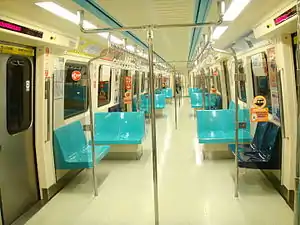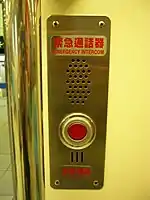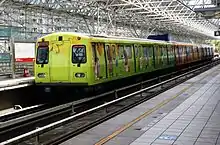Taipei Metro C371
The Taipei Metro C371 is the fourth generation of an electric multiple unit train type currently used on the Taipei Metro Songshan–Xindian line, Zhonghe–Xinlu line, Xinbeitou branch line and Xiaobitan branch line.
| Taipei Metro C371 | |
|---|---|
 A Taipei Metro C371 train on the Tamsui Line. | |
 Interior Design of a C371 train | |
| In service | 2006–present |
| Manufacturer | Kawasaki Heavy Industries and Taiwan Rolling Stock Company |
| Built at | Kobe, Hyōgo, Japan; Hsinchu, Taiwan |
| Constructed | 2005–2009 |
| Number built | 321 vehicles (55 sets) |
| Formation | 3 x 2–cars per trainset (301/302-337/338, 401/402-465/466) 3 cars per trainset (397-399) |
| Fleet numbers | 301/302–337/338 (1st batch) 401/402–465/466 (2nd batch) 397~399 (for branch lines only) |
| Capacity | 1914 passengers |
| Operator(s) | Taipei Rapid Transit Corporation |
| Depot(s) | Xindian (301/302-337/338, 397-398) Zhonghe/Luzhou (401/402-465/466) Beitou (399) |
| Line(s) served | |
| Specifications | |
| Car body construction | Stainless Steel |
| Car length | 23.5 m (77 ft) |
| Width | 3.2 m (10 ft) |
| Height | 3.6 m (12 ft) |
| Maximum speed | Design: 90 km/h (56 mph) Service: 80 km/h (50 mph) |
| Weight | 39.5 t (DM1/M2) 34 t (T) |
| Traction system | IGBT-VVVF (Mitsubishi Electric) |
| Electric system(s) | 750 V DC Third rail |
| UIC classification | Bo'Bo' + 2'2' + Bo'Bo' + Bo'Bo' + 2'2' + Bo'Bo' (six-car set), Bo'Bo' + 2'2' + Bo'Bo' (three-car set) |
| Braking system(s) | Regenerative and disc brakes[1] |
| Safety system(s) | ATC (ATO), ATS |
| Coupling system | Tomlinson |
| Track gauge | 1,435 mm (4 ft 8 1⁄2 in) standard gauge |
History

In 2003, the Department of Rapid Transit Systems (DORTS) of Taipei ordered 321 subway cars from Kawasaki Heavy Industries. Among these vehicles, 144 of them was to be used on the then-upcoming Luzhou and Xinzhuang Sections of the Zhonghe-Xinlu line whereas the remaining 177 cars were to increase the capacity of the existing network. As part of the Industrial Cooperation Program mandated by the Taiwanese government, the first half of trains were built by Kawasaki at its rolling stock plant in Hyōgo whereas the other half was to be built domestically by the Taiwan Rolling Stock Company (TRSC).[2]
The C371 trains were built in two different batches:
- The first batch of trains (numbered in the 300-series; built from 2005-2007) were completely built-up by Kawasaki in Japan and were part of contracts TA001 (the main batch), CH321A (a 3-car set for the Xiaobitan branch line) and CE361 for the Nangang section eastern extension of the Bannan line.[3]
- The second batch of trains (numbered in the 400-series; built from 2008 to 2009) were built specifically for the Zhonghe-Xinlu line and were part of contracts CE601 (for the Luzhou section) and CK371 (for the Xinzhuang section). Sets 419 to 430 were built by Kawasaki whereas the remainder were assembled from complete knock-down (CKD) kits imported from Nippon Sharyo by TRSC.[4]
In 2006, the first C371 trainset was introduced into service on the Xiaonanmen Line (the CKS Memorial Hall-Ximen segment of the Songshan-Xindian line). Deliveries of the trains continued until June 2009.[2]
Overview

The C371 retains a largely similar design seen on the C301, C321 and C341. Unlike its earlier counterparts however, the C371 had several differences as follows:[3][5][2]
- The C371 uses a quieter IGBT-VVVF from Mitsubishi Electric as compared to earlier train types. It sounds very similar to that of the CT251 trains for Singapore's MRT.
- The end cars now feature completely longitudinal seating instead of transverse seating traditionally used on Taipei MRT trains.
- The passenger doors now use electric door actuators instead of pneumatic ones.
- Security cameras were already installed on board the trains when new.
- Priority seats now take on a darker shade of blue.
- Taillights are now LED.
- An additional door chime is added for doors opening.
- The front LED destination display now uses a larger font and is brighter in improve visibility.
- The driving console includes a train supervising information system (TSIS) to assist driving and maintenance.
- Bicycle storage spaces are fitted in the interior
- The second batch trains use a different design of emergency communication button from the first batch.
Set 399

In 2009, Kawasaki also supplied a 3-car set numbered by DORTS as 399 for the Xinbeitou branch line. Set 399 notably stood out among the other C371 trainsets as it was designed as a concept advertisement train to promote the hot springs in Xinbeitou. While sharing the same technical specifications with the other C371 trainsets, set 399 had a multi-colour livery and featured a unique interior design with the theme of onsen in mind.[6]
Fleet numbering
A complete six-car trainset consists of an identical twin set of one driving motor car (DM1), one trailer car (T) and one intermediate motor car (M2) permanently coupled together. The configuration of a six-car C371 trainset in revenue service is DM1–T–M2–M2–T–DM1 whereas that for a three-car trainset is DM-T-DM.
Each car is assigned its own four-digit serial number, which ranges from x301 to x338 (1st batch; 6-car sets), x397 to x399 (3-car sets for branch lines), and x401 to x430 (2nd batch; 6-car sets).
- The first digit (the 'x' above) indicates the position of the car. Hence, DM1 cars use the number x=1, T cars x=2, and M2 cars x=3
- The other three digits are the identification number of the train the car is part of. A full-length train of six cars consists of two identification numbers, one for the first three cars, and another for the second three. The bigger number is always equal to the smaller number plus one, and the smaller number is always an odd number. For example, a train of six cars would have serial numbers 1301, 2301, 3301, 3302, 2302, and 1302, respectively.
See also
References
This article incorporates information from the corresponding article on the Japanese Wikipedia.
- 蘇, 昭旭 (2014). 台灣鐵路火車百科:台鐵·高鐵·捷運 第三版. Taiwan: 人人出版. ISBN 9789865903404.
- "Subway Cars Delivered to Taipei". Kawasaki Heavy Industries. 5 December 2005.
- "第五章 捷運列車介紹". fgu.edu.tw.
- "台湾地下鉄DORTS". Nippon Sharyo.
- "台北捷運C371型 -- VVVFインバータ制御・淡水線~新店線、新北投支線、小碧潭支線". VVVF web.
- "台北捷運車輛簡介". club.nte.edu.tw.
| Wikimedia Commons has media related to C371. |